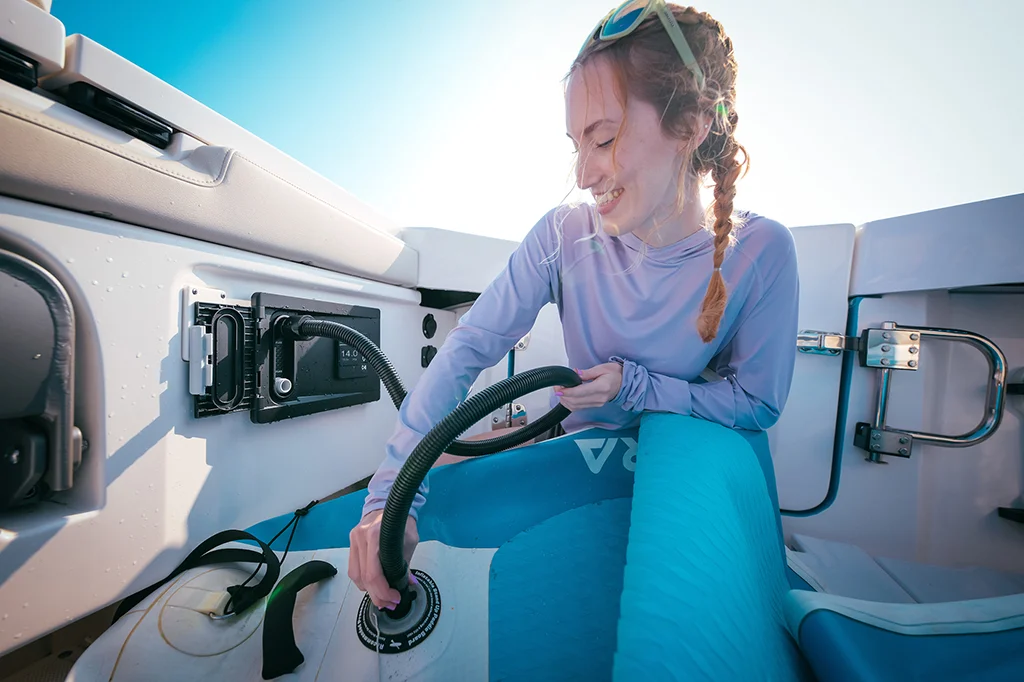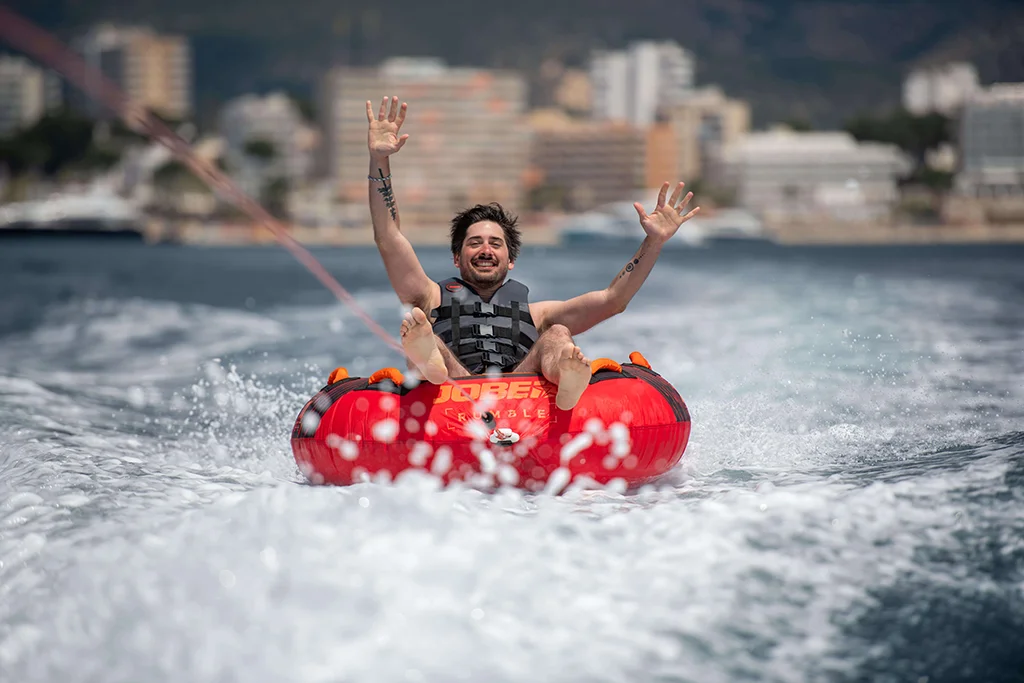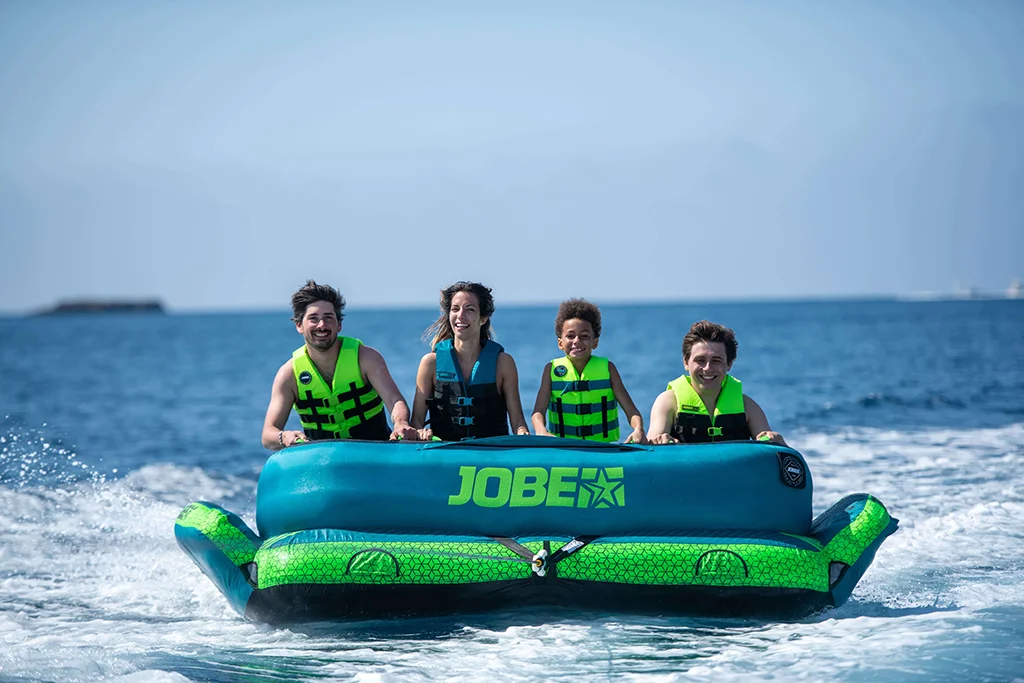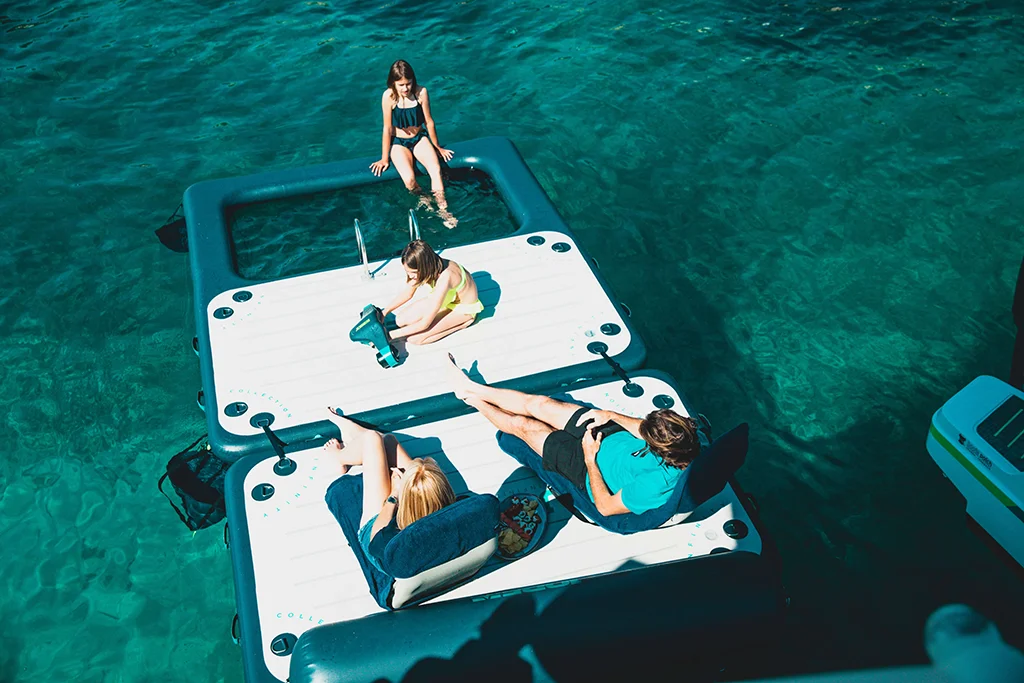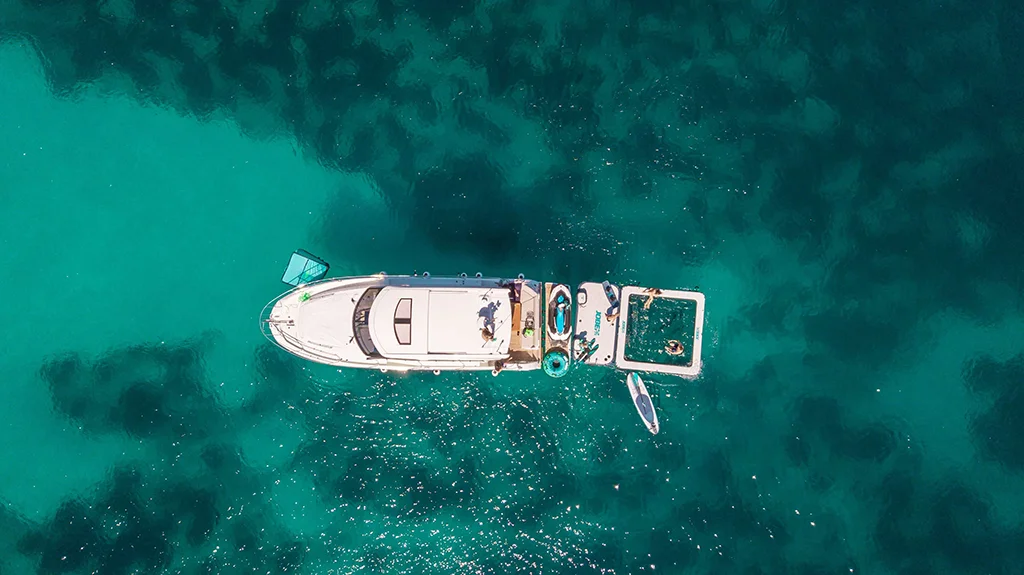 Choosing The Right Inflatable Toys For Your Boat
Choosing The Right Inflatable Toys For Your Boat
From tenders to towables, sofas to slides, paddleboards to pools, donuts to docks there are many air-filled options to enhance your boating experience. Whether you wish to explore places that your yacht, motorboat or RIB cannot reach or you are looking for ways to entertain your kids and guests, there are inflatables for everyone.
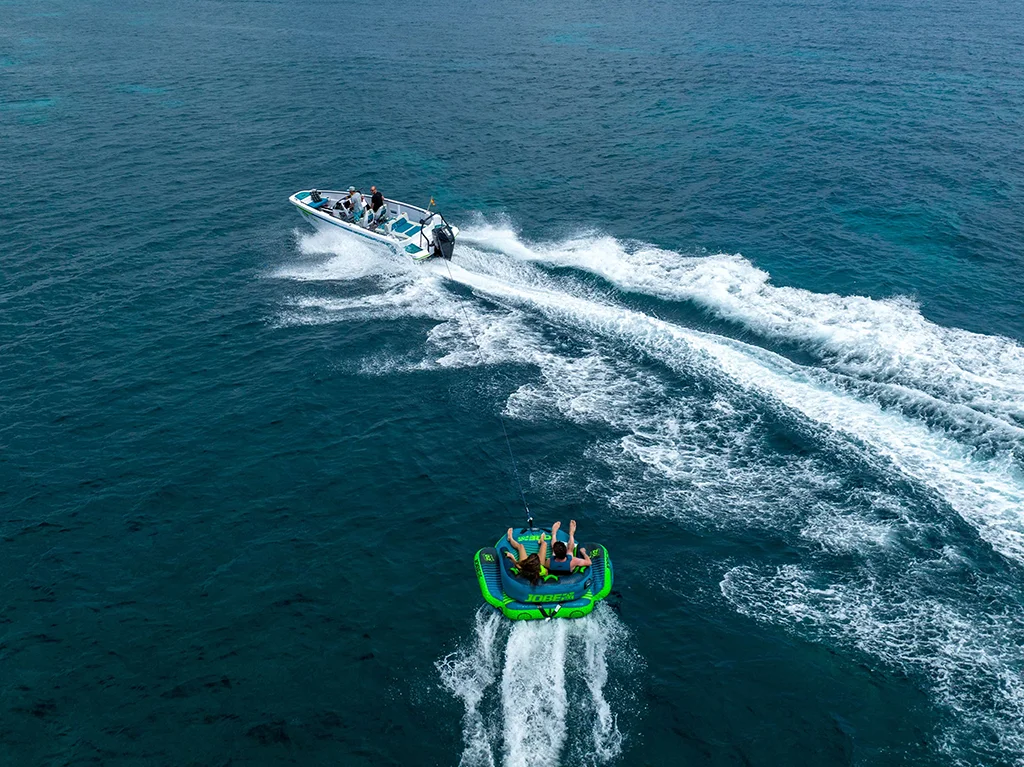
Jobe Binar Towable being towed by an Axopar X Jobe Revolve XXII powerboat
Every boat will benefit from an inflatable on board. Some serve practical purposes, such as transporting you and your guests from your anchored or moored boat to the shore, while others are purely for fun and laughter. Certain inflatables keep you out of the water, while others ensure you end up in it. The only drawbacks to inflatables are the processes of inflating, deflating, and stowing them – simplify these, and you're all set.
Safety First
When venturing onto the water with a tender, SUP or towable, prioritize safety and think about a personal flotation device. For a tender it could be a lifejacket from your boat, for a SUP it could be a belt PFD (Personal Flotation Device), and for towables, a rugged buoyancy aid (such as those designed for wakeboarding or waterskiing) will be needed to prevent it from coming off when you skim across the water like a human pebble. Regardless of your choice, ensure you have a properly fitting device for each person.
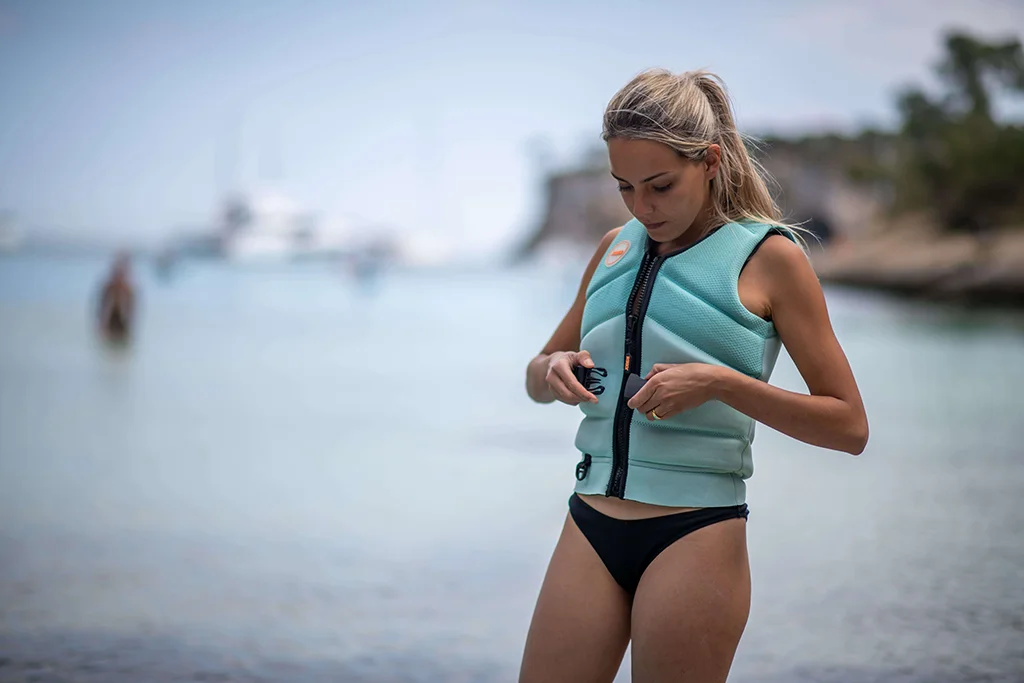
Life Vests or PFD are a must-have for your on-water activities
How And Where Will You Inflate It
Before you start choosing an inflatable, consider how and where you plan to inflate, deflate and stow it. Most inflatables come with a pump of one type or another, usually a manual foot pump or hand pump. These can often provide entertainment to parents or crew members who are happy to watch a pump skating around a GRP deck while the operator gradually turns different shades of red. Boat owners with teak decks should avoid using these pumps on them unless the deck is protected or a distressed teak deck is a look you aspire to.
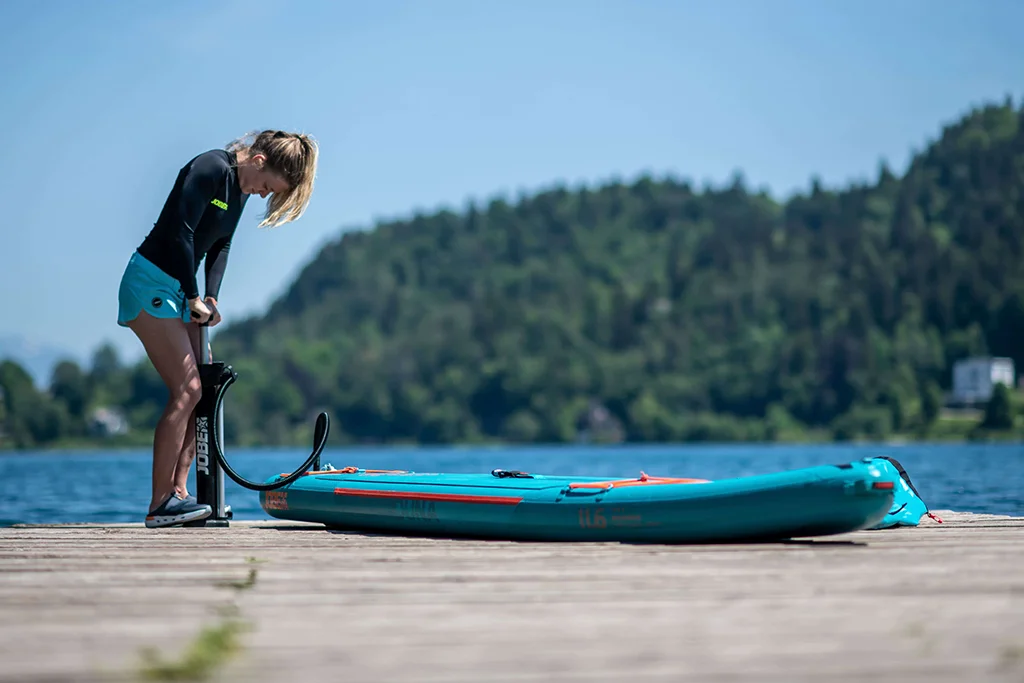
Beat the drudgery of manually pumping up an inflatable with a manual pump!
When owners realize what a faff manual pumps are, many opt for an electric pump to prevent their inflatable from becoming the nautical equivalent of a ‘must-have’ kitchen gadget – used once then destined to spend the rest of its life at the back of a cupboard. However, not all pumps are made for a salt-laden atmosphere and they often succumb to corrosion.
Electric inflators typically need connecting to the boat’s batteries, which are often under bunks or in hard-to-access places. Therefore it’s crucial to consider the accessibility of your batteries before committing. If you choose a cordless inflator, ensure you keep it charged and remember to attach it with a piece of cord to avoid losing it overboard as your inflatable grows – and yes, we realize the irony of adding some cord to a cordless inflator. The best option is a built-in pump that’s always on hand where and when you need it. Scanstrut’s award-winning inflator was designed for use at sea and can be set to the correct pressure and left to operate automatically, stopping when the inflatable reaches this pressure. You’ll be able to enjoy a drink while watching ATMOS, and other boat owners, doing all the work. Then, once you’ve finished with your inflatable fun, you can relax while ATMOS deflates it for you.
ATMOS 12V Integrated Air Station doing all the hard work
Where Will You Keep Your Inflatable
You may consider an unused cabin as a good home for an inflatable, but lockers and lazarettes are better. To prevent unpacking a slime-covered inflatable with the aroma of mushrooms, it's best to rinse and thoroughly dry off your inflatable before packing it away. Saltwater is best avoided, it will leave salt crystals as the water evaporates, attracting moisture from the air. Rinsing with freshwater, either on deck or in harbour, reduces the likelihood of encountering fungal fright when you next unpack your inflatable.
Types Of Inflatable Toys
Inflatables can be broadly split into three categories: Active, Towable, and Static. The choice between them depends on your boat. Active inflatables can be used for travelling and exploring places where the mothership can't reach. They can be used independently from a yacht, motorboat, RIB or sportsboat. Towable inflatables are, as their name suggests, towed behind motorboats. Statics remain stationary, attached to your boat, providing additional deck space or enhancing your time in the water surrounding your boat.
Active and Practical:
Tenders, Kayaks And Paddleboards
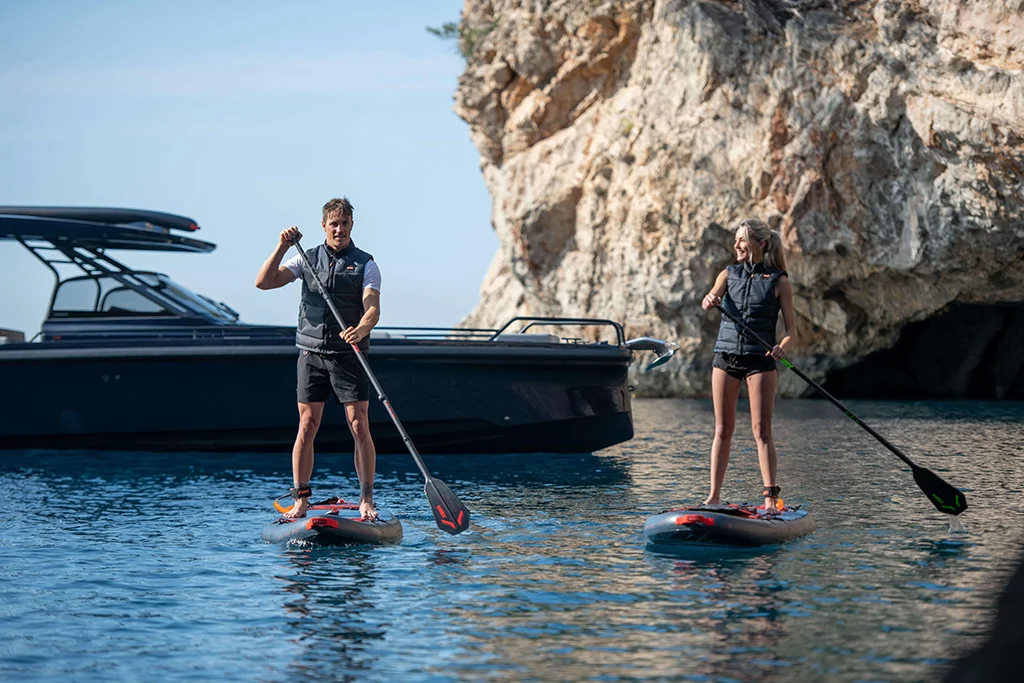
Paddleboards are great for use around yachts, motorboats and RIBs
Unless you only ever sail between marinas, or your boat is small enough to beach, you'll benefit from having a tender. While hard tenders are available, an inflatable tender is much easier to transport and it can bounce harmlessly alongside your boat rather than bashing it. They are usually much more stable than rigid tenders, too. Some tenders are designed to be easily deflated and stowed, while others like RIBs (Rigid Inflatable Boats) are meant to be kept inflated even when stowed. Hybrid FRIBs (Foldable Rigid Inflatable Boats) have a folding solid hull for improved performance while offering the convenience of fully inflatable tenders.
Inflatable tenders can be rowed, but more often they are propelled by an outboard motor, unless you opt for a jet RIB powered by a waterjet. Tenders enable you to go ashore when there's nowhere to moor your yacht and they are useful for transporting kit, crew and shopping to and from your boat. They are excellent for exploring for exploring rivers, creeks and coastal areas that may be uncharted or too shallow for bigger boats.
For those who like exploring without a motor, inflatable kayaks are an option. While these can serve as tenders for couples or singlehanded cruisers, they lack the load-carrying capacity and stability of an inflatable boat. They are versatile and can be packed away into a large backpack - to use them on local rivers or canals, for example. Add a coolbox and you can venture up a river for the day and find a nice spot for a lunchtime picnic.
A stand-up paddleboard or SUP is great for those looking to supplement their boating with another activity. They are increasingly popular and, like inflatable kayaks, can fit into a backpack to be used on holiday or local waterways and lakes. These boards typically require a higher pressure to retain their rigidity. Most manual pumps require the user to switch the inflation tube from the high-volume nozzle to the high-pressure one. With Scanstrut's ATMOS pump the transition from high volume to high pressure is automatic. SUPs offer a great way to enjoy calm evenings and a slower pace of life. They can also be used for quick trips to the shops (if you have a waterproof backpack), and some models can be used like a kayak.
Inflatable Kayaks are a great way to see a coastline.
If you like the idea of an SUP but are unsure about your stability (or core strength) there are pedalboards. These have fixed handlebars to hold onto and are operated in a stepping motion that drives propelling fins beneath the board.
Last on the active list are inflatable sailing dinghies. These can be catamarans or monohulls and can be sailed from a boat or a beach. Depending on whether you want high performance, to enjoy pottering around by sail or a way to keep the kids entertained there are many options available. Because of the extra rigging it can take around 15-30 minutes to get them ready to sail.
Fast And Fun:
Towables
Inflatable toys for motorboats, sports boats and RIBs
Towable inflatables come in various shapes and sizes. There are donuts to sit in, sofas to perch on or decks to lie on. Additionally, there are hybrids that you can stand, kneel or sit astride. Low to the water, towables provide an exaggerated feeling of speed, and upon hitting a wake or wave they can become airborne, adding to the excitement. Before delving into the specifics of each type, it's essential to cover some basics regardless of the type of towable you're interested in.
First and foremost, you need a motorboat – one capable of achieving at least 8 knots with some torque to spare and equipped with a boarding ladder or steps to safely retrieve people from the water. However, speeds above 20mph/18kts aren't necessary. You'll require a competent driver and a spotter – someone keeping an eye on the victim, sorry, rider.
Both rider and spotter should have hand signal prearranged (signs for stop, faster, slower, all good, I've had enough, will cover most eventualities). Insurance is also crucial; while many policies cover water-skiing and wakeboarding they may not extend to towable inflatables. You'll also need a towrope designed for the job. Don't be tempted to use any piece of rope you have lying about, tow ropes have elasticity that softens the acceleration snatch loads, enabling you to stay on your towable for longer. Lastly, remember that it should be fun – for everyone, not just the boat driver and spotter. Respect the rider's wishes, as while it might seem placid on the boat, the rider will be having a completely different experience.
There are towables designed specifically for kids, but many towables can be used at slower speeds appropriate for age and experience. Alternatively, an adult can accompany a child on a platform that can accommodate two people or more. When buying a towable, look not only for comfy padded handles but also the material under them as this is where the rider's knuckles will rub.
Sofa-style inflatables are just as thrilling as other inflatables and a bit gentler on the arms!
Donuts are small and an affordable way to start. Resembling large, fabric-covered car tyre inner tubes with a fabric base, the rider sits in the centre facing forward. These are available in 1/2/3 person layouts, are quick to inflate and take up little room when deflated, so they can be easily stored regardless of whether you have a small bow rider boat, a sports boat, a RIB or something bigger.
Inflatable sofas have a backrest and room for at least two people. They can be just as thrilling as other inflatables and a bit gentler on the arms. Some sofas offer the ability to be towed in reverse like a chariot.
For a different experience, there are towable decks on which the rider lies face down. Longer decks tend to be more comfortable, preventing lower legs and feet from dragging through the water. Also, when the towrope catches on the wake you can put your head down to avoid a face full of spray. Because of their large size and flat shape, becoming airborne is a regular feature and you can use your body weight to steer, too.
Finally, there are hybrids. These come in many designs, giving you the option to sit, kneel, or lie down as they spin, wobble and fly across the water. If you want to sit astride a long inflatable banana, hotdog, shark, or fighter jet, you can. Many of these combine a deck for stability with a choice of rider positions, ensuring you get the most from your inflatable.
Relaxing and Static:
Islands, Pools and Slides
The simplest form of static inflatable is an island raft that provides you with a large, open place to relax and perhaps do some yoga. More complex statics include modular water parks with climbing walls, slides and balance beams. The space you have on board will constrain your ambitions but if you own a superyacht there's no end to how big your inflatable dreams can get.
Island rafts and platforms are an excellent way of increasing deck real estate. They can be play spaces for kids or sunbathing platforms for adults, either tied alongside or floating behind the boat on a tether. Numerous attachments and accessories are available, such as bathing ladders, parasols, inflatable cushions etc. Importantly, they provide a large flat space – something not often found on boats under 11m (40ft). From islands and rafts have evolved docks; these have cutouts for jet skis and other personal watercraft, making it easier for riders to mount and alight, alight and keeping them away from the polished parts of your boat. For those who enjoy swimming, but cruise in waters plagued by jellyfish, inflatable swimming pools are islands with a central cut-out and a net beneath. If your waters are free of nasties, you can get inflatable slides or floating islands with built-in seating, giving you a poolside experience from the privacy of your yacht.
While all these inflatable options are available, it doesn't mean you should rush out and buy them all. The larger the inflatable, the more room it will occupy on board. There's no point having a new inflatable it's going encroach on your living space on the mothership. Whatever range of inflatables you decide to have on board, it makes great sense to have a single, permanently installed inflator for all of them, rather than having to carry a clutter of different valves, hand and foot pumps.

